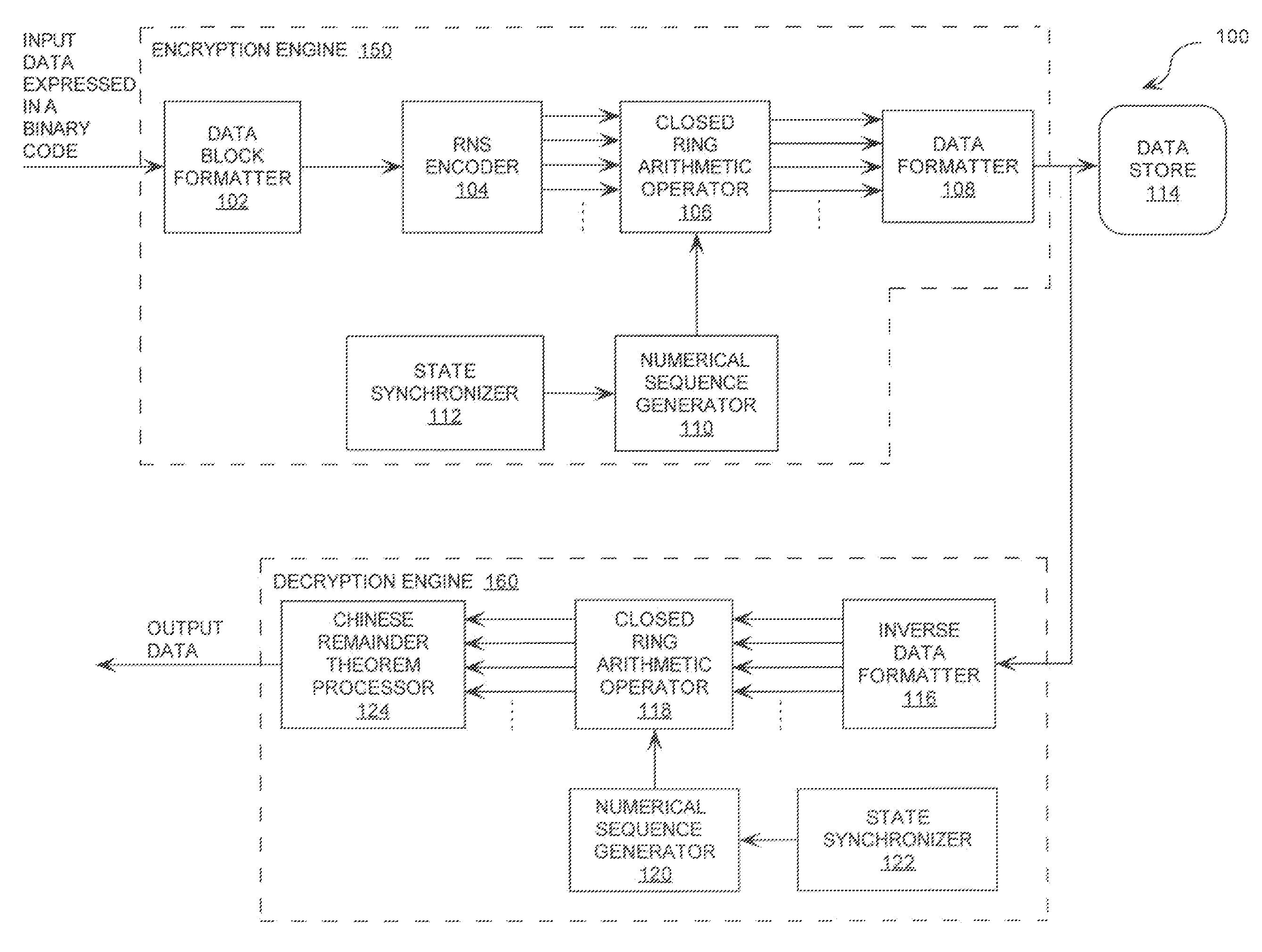Encryption Via Induced Unweighted Errors
- Summary
- Abstract
- Description
- Claims
- Application Information
AI Technical Summary
Benefits of technology
Problems solved by technology
Method used
Image
Examples
example 1
[0026]A first data block is comprised of a binary bit sequence 00001001 representing a horizontal tab, the tenth character of the ASCII character set. As will be understood by a person skilled in the art, the binary bit sequence 00001001 has a decimal value of nine (9). As the Extended ASCII character set has 256 possible values with decimal values from zero (0) to two hundred fifty-five (255) and corresponding binary values from 00000000 to 11111111, the moduli set must supply a dynamic range M=m0, m1, . . . mP-1. P is the number of moduli of at least two hundred fifty-five (255). Three (3) moduli m0, m1, m2 are selected to have values of seven (7), eight (8), and nine (9). This gives a dynamic range of five hundred four (504). Accordingly, the RNS representation of the data in the first block can be computed using Equation (1).
R={Vbbs modulo m0, Vbbs modulo m1, Vbbs modulo m2} (1)
where R is a residue value 3-tuple for the data in a data block. Vbbs is a value of a binary bit seq...
example 2
[0041]Briefly, an input data “the quick brown fox” is generated and converted into a residue number system representation using modulo operations. The residue number system employed is selected to have moduli three (3), five (5), and nineteen (19). Thereafter, a manipulation in residue space is performed by simply flipping the least significant bit (LSB) in the mod three (3) moduli illustrating the principle that a very predictable manipulation of the same bit in residue space
%% Define primes%p(1) = 3;p(2) = 5;p(1) = 19;%% Calculate M%capm = prod(p);%% Define b's%b(1) = 2;b(2) = 3;b(3) = 14;%% Define M / p's%mop(1) = 5*19;mop(2) = 3*19;mop(3) = 3*5;%% Define input string%str =’The quick brown fox’:seq = uint8(str);intct = length(seq);%%Begin conversion into residue space%resarr = zeros(3,intct);for ind = 1:intct for ind1 = 1:3 resarr(ind1,ind) = mod(seq(ind),p(ind1)); endend%% Insert encryption fcn here.%for ind = 1:intct bv = dec2bin(resarr(1,ind),2); if bv(1) == ‘0’ bv(1) = ‘1’; e...
example 3
[0043]Briefly, an input data is generated and converted into a residue number system representation using modulo operations. The input data includes:
“In classical physics, due to interference, light is observed to take the stationary path between two points; but how does light know where it's going? That is, if the start and end points are known, the path that will take the shortest time can be calculated. However, when light is first emitted, the end point is not known, so how is it that light always takes the quickest path? In some interpretations, it is suggested that according to QED light does not have to—it simply goes over
Physically, QED describes charged particles (and their antiparticles) interacting with each other by the exchange of photons. The magnitude of these interactions can be computed using perturbation theory; these rather complex formulas have a remarkable pictorial representation as Feynman diagrams. QED was the theory to which Feynman diagrams were first appli...
PUM
 Login to View More
Login to View More Abstract
Description
Claims
Application Information
 Login to View More
Login to View More - R&D
- Intellectual Property
- Life Sciences
- Materials
- Tech Scout
- Unparalleled Data Quality
- Higher Quality Content
- 60% Fewer Hallucinations
Browse by: Latest US Patents, China's latest patents, Technical Efficacy Thesaurus, Application Domain, Technology Topic, Popular Technical Reports.
© 2025 PatSnap. All rights reserved.Legal|Privacy policy|Modern Slavery Act Transparency Statement|Sitemap|About US| Contact US: help@patsnap.com



